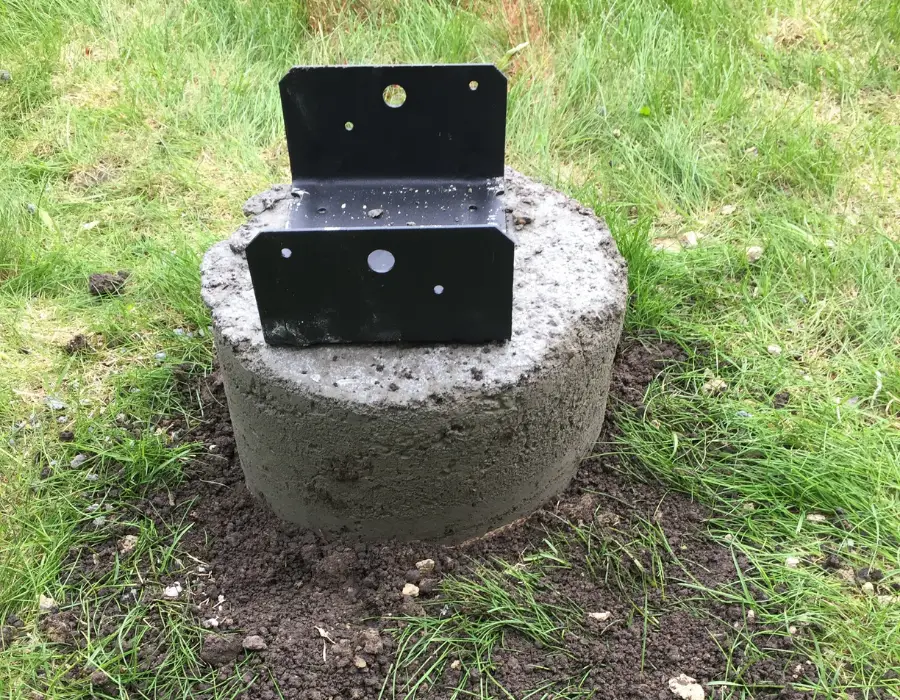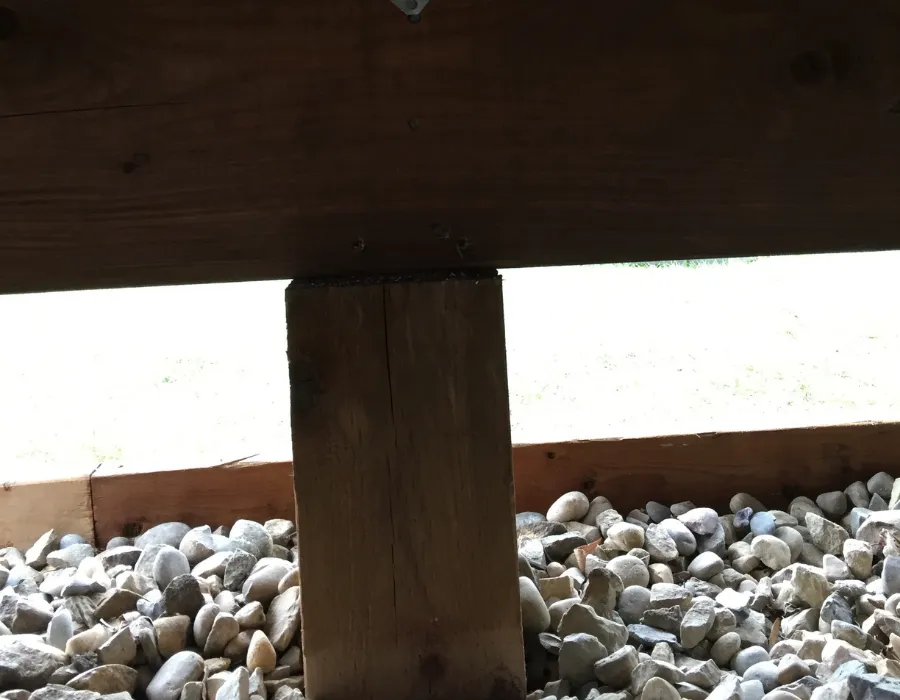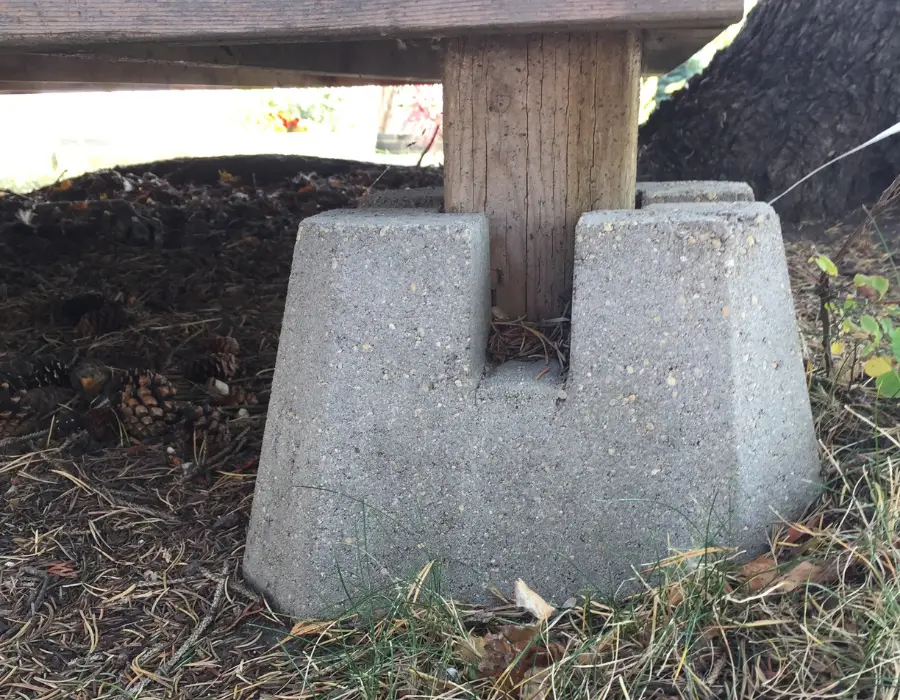Building a new deck is an extremely exciting endeavor for most homeowners. This home feature presents the opportunity to enjoy a host of outdoor activities and take advantage of the good weather whenever the opportunity presents itself. However, one of the most important parts of the deck is unseen – the footing.
There are several types of deck footings, including poured concrete footings, buried post footings, screw piles, precast concrete blocks, and precast stackable footings. Deck footings are essential to ensure that your deck can withstand the forces placed on it and that it lasts as long as possible.
While there are several options for deck footings, you must choose the deck footings that will be best suited to your specific project. Several factors will influence your choice of deck footing that will work for your project. Understanding these factors will help you decide.
Types Of Deck Footings
There are several types of footings available for decks. The importance of deck footings cannot be underestimated because they provide the support needed to ensure the deck will remain standing. Generally, half of a deck’s load goes to the ledger board of the house (for an attached deck), and the other half goes to the footings.
To choose the correct type of deck footings, you will first have to consider whether the deck is attached to the house or a freestanding deck. The building codes will need to be consulted to establish the restrictions and expectations in your area.
Your deck’s height and overall size will also influence what type of footing will work best for your specific situation.
The types of deck footings to be discussed here include:
- Poured concrete footings
- Buried post footings
- Precast concrete blocks
- Precast stackable concrete footings
- Screw piles
Each footing type has its advantages and disadvantages. Still, each will be effective in the majority of circumstances to ensure your deck’s longevity and functionality.

Poured Concrete Deck Footings
A poured concrete footing is a good option when building a large deck that sits high up from ground level. Concrete is extremely strong and able to withstand extreme forces and substantial weights.
A poured concrete footing is created by digging a hole and pouring concrete into it. The hole must reach below the frost line to ensure maximum effectiveness. While the frost line is usually around 40″ deep, it can be as deep as 70″ in some regions of the US.
In Canada the required depth for deck footings varies from 18″ to 96″ (0.48-2.44m) depending on the region.
varies from 18″ to 96″ (0.48-2.44m) depending on the region.
The deeper the frost line, the more labour-intensive the process of installing poured concrete footings becomes. Installing poured concrete footings is already an intensive process that becomes more labour-intensive as there is an increase in the depth to which the footings need to be poured.
Most local building also dictate how big the concrete column needs to be. Ranging from 8″ (200mm) diameter column to 24″ x24″ (600mm x 600mm) concrete pad and column. But most require a minimum of 10″ (250mm) concrete column.
If you are building a deck on extremely soft soil or your deck is extremely heavy, you may need to create a wider footing at the base of your concrete pillar. This wide footing sits below the frost line and supports the entire structure. It is attached to the column above with rebar.
Cost of Concrete Footings
The biggest cost here is labour, with the material cost being little compared to the time it will take to dig the hole and mix the concrete.
Material is roughly $12 a foot for sono (cardboard) tube plus bags of premixed concrete. Add $10 for the post saddle to anchor the post to the concrete a lift it out of any water that pools on the concrete. Putting material for a 4′ (1.2m) footing at just under $60.
But then we have the labour to dig the hole. A clamshell post hole digger in soft soil can do this in under a hour. But if the clay is hard or you hit rocks, that will quickly escalate. So expect most professionals to charge between $200 to $400 a footing.
A specialized deck builder will often use a power auger attached to a skid steer (Bobcat), making the job much easier. But getting to the backyard can be tricky.

Buried Post Deck Footings
Similar to a poured concrete footing, a buried post footing will also require a hole to be dug below the frost line. Once this depth is reached, concrete is poured to form a footing.
A pressure-treated timber post is then secured to the footing, which extends up above the ground level to attach to the deck structure, and the space around the pole is backfilled. This foundation type will be able to support a significant load due to the concrete footing.
*Builder Tip*
I am not a fan of this method because of the potential of the post rotting in the ground. Even ground-treated pressure-treated wood will rot over time when buried. Wood needs to be able to dry out to minimize rot.
A buried post footing will require far less concrete than a poured footing. This will allow for a significant saving in the time and overall cost associated with creating the foundation for your deck.
Overall, a buried post footing will provide the same amount of support and structural strength as a poured footing. However, this is achieved without the enormous amount of concrete that is required for a standard poured footing.
Price of Buried Footing
Similar to a poured concrete footing, except the height is a wood post.
- $12 for ready-mixed concrete
- $10 for the post saddle
- $50 for a 8’ (2.4m) 6×6 post
Total material cost, $72. Slightly higher than poured concrete, but to be fair, poured concrete also needs a post unless the deck is low to the ground and you rest the beam directly on the concrete pile.
Labour is the same pour concrete. Often costing $200-$400 to dig the hole and place the concrete and post.

Precast Concrete Deck Blocks
Precast concrete block footings are the cheapest option when it comes to deck footings. These footings are buried just below the surface of the ground. The tops of the blocks are notched so as to allow the treated timber structural elements to fit into and attach to them in order to build your deck.
Precast concrete block footings require a close placement to one another. This means that you would need a significant number of blocks when compared to other types of footings.
Because this type of footing is not buried deep beneath the ground, high wind loads can potentially cause the deck to lift off the blocks. It is for this reason that precast concrete block footings do not generally meet building codes in many regions.
This footing type is generally best suited to decks that are built low to the ground and are not attached to the building. They are nowhere near as strong or stable as poured concrete footings or buried post footings.
Price of Precast Concrete Deck Blocks
This is the cheapest of deck footings. A deck block and some gravel/sand for under the deck block will cost under $50 a footing. Labour is also minimal as the block is installed just below the topsoil requiring minimal digging.
will cost under $50 a footing. Labour is also minimal as the block is installed just below the topsoil requiring minimal digging.
Costing less while requiring less work make this a good option for the right deck.
Click the link to learn more about when deck blocks are a good idea for a deck.
for a deck.
Precast Stackable Concrete Deck Footings
Precast stackable concrete footings are an excellent choice of footing that provide the same amount of strength and stability as a poured concrete foundation. The difference lies in the construction method.
Poured concrete footings require concrete to be poured on-site, either directly into the ground or into a mold. However, precast stackable concrete footings are simply dropped into place inside a hole and do not require any mixing or pouring of concrete. The blocks are heavy, about 60 lbs each.
The advantage is that you will not have to wait for concrete to dry before continuing your construction process. It also means that you don’t have to worry about mixing the concrete correctly.
A hole is required that reaches below the frost line. The next step is to lower the individual components of the footing into the hole one at a time, stacking them on top of each other. Each component is attached to a threaded anchor that extends through the center of the concrete stack.
Price of Stackable Concrete Footing
Availability will be a bigger problem than price with this footing as they are not readily stocked at most building supply stores. But at Home Depot you can order a 54”, 5 pieces stackable column costs $180.
Installation requires digging a larger hole than poured concrete as you will need to be able to place and adjust the blocks. Plus, the dirt wil need to be filled in again around the concrete column. Bringing the cost of a stackable concrete footing between $300-$500 each.

Screw Piles Deck Footings
Screw piles – also referred to as helical piles – are pre-manufactured footings made out of steel. These are essentially screwed into the ground until at the correct height.
There are two methods of installation, depending on use.
For permitted decks requires hydraulic machinery to install. The hydraulics are required to provide sufficient tourque to drive the helix into the ground. Plus, the required torque must be read and recorded to prove sufficient resistance and strength of the pile. This can require additional shafts to be added in soft soil conditions.
However, the benefit of this is that no digging of large holes is required before the footings can be put into place. No holes also means no dirt to dispose of. It is amazing how much dirt comes out of a footing hole.
Quick installation is another advantage of this type of footing, but this comes at the cost of hiring a professional team to do the job. Screw piles are extremely strong and durable and will ensure a stable deck structure throughout their lifetime.
For unpermitted decks there are DIY screw piles like the Pylex screw pile. Which can be screwed in by hand to a depth of 3’-4’ depending on how hard the soil is. The advantage is you can have frost footings without all the digging and dirt. But most jurisdictions will not allow their use because you can not verify the load-bearing strength limiting their application.
Cost of Screw Piles
Going the non-permitted DIY option will cost around $60 a footing, not including labour. This is DIY, so you are installing it and you are working for free. Have fun.
For a permitted deck installed by a professional, the price will range by region and site access. I have had to remove and rebuild entire section of a fence to provide access. But just installing a helical pile will cost between $200-$400 each.
Conclusion
While the footings for your deck are generally hidden from view, they remain an extremely important part of the construction of your deck. By establishing the correct type of footing for your foundation, you will ensure that your deck is able to withstand all the forces it may be forced to endure at any stage of its life.
